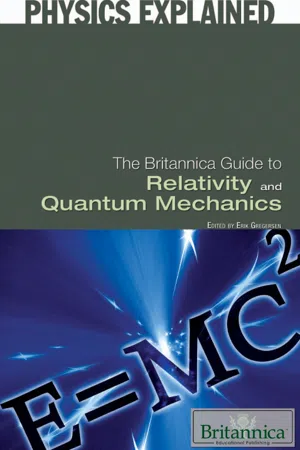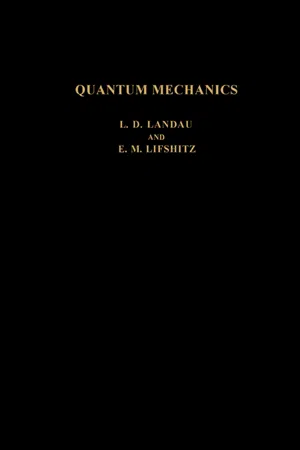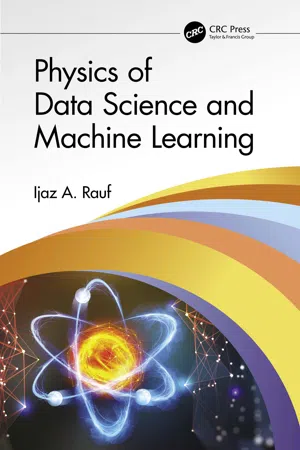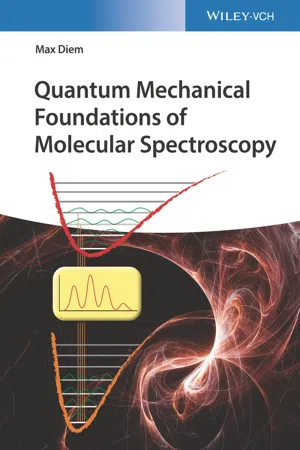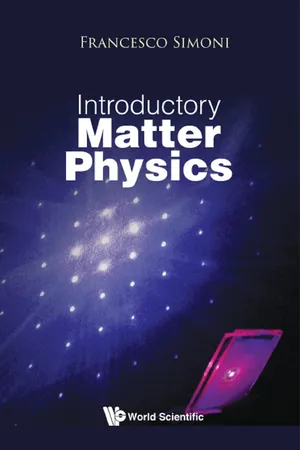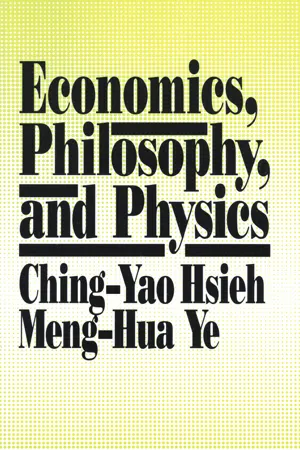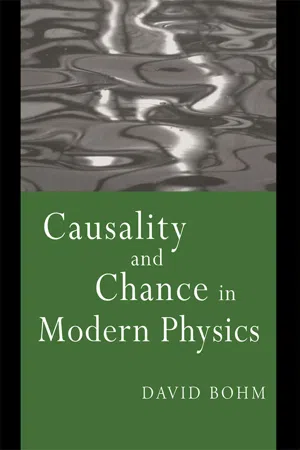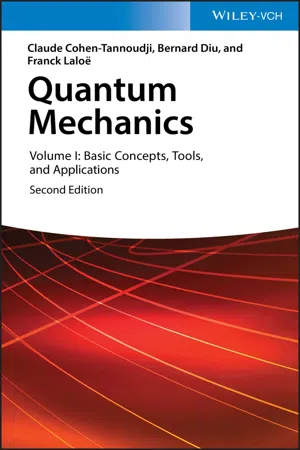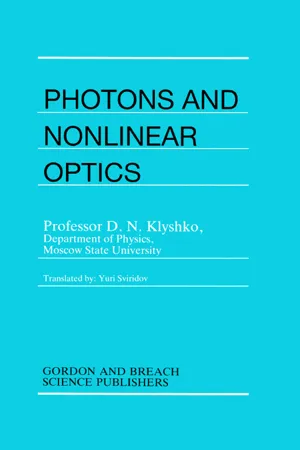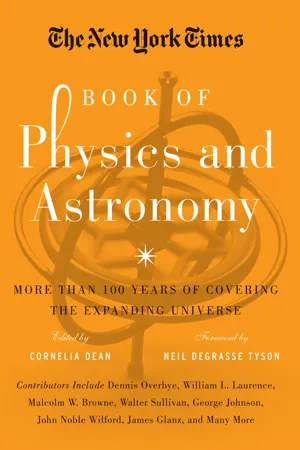Physics
Quantum Mechanics
Quantum mechanics is a fundamental theory in physics that describes the behavior of matter and energy at the atomic and subatomic levels. It introduces the concept of quantized properties, such as energy and angular momentum, and provides a framework for understanding phenomena like wave-particle duality and quantum entanglement. The theory has profound implications for our understanding of the nature of reality at the smallest scales.
Written by Perlego with AI-assistance
Related key terms
Related key terms
1 of 4
Related key terms
1 of 3
11 Key excerpts on "Quantum Mechanics"
- Britannica Educational Publishing, Erik Gregersen(Authors)
- 2010(Publication Date)
- Britannica Educational Publishing(Publisher)
CHAPTER 3 QUANTUM MECHANICS : CONCEPTSQ uantum mechanics is the science dealing with the behaviour of matter and light on the atomic and subatomic scale. It attempts to describe and account for the properties of molecules and atoms and their constituents—electrons, protons, neutrons, and other more esoteric particles such as quarks and gluons. These properties include the interactions of the particles with one another and with electromagnetic radiation (i.e., light, X-rays, and gamma rays).HISTORICAL BASIS OF QUANTUM THEORY
At a fundamental level, both radiation and matter have characteristics of particles and waves. The gradual recognition by scientists that radiation has particle-like properties and that matter has wavelike properties provided the impetus for the development of Quantum Mechanics. Influenced by Newton, most physicists of the 18th century believed that light consisted of particles, which they called corpuscles. From about 1800, evidence began to accumulate for a wave theory of light. At about this time Thomas Young showed that, if monochromatic light passes through a pair of slits, the two emerging beams interfere, so that a fringe pattern of alternately bright and dark bands appears on a screen. The bands are readily explained by a wave theory of light. According to the theory, a bright band is produced when the crests (and troughs) of the waves from the two slits arrive together at the screen; a dark band is produced when the crest of one wave arrives at the same time as the trough of the other, and the effects of the two light beams cancel. Beginning in 1815, a series of experiments by Augustin-Jean Fresnel of France and others showed that, when a parallel beam of light passes through a single slit, the emerging beam is no longer parallel but starts to diverge; this phenomenon is known as diffraction. Given the wavelength of the light and the geometry of the apparatus (i.e., the separation and widths of the slits and the distance from the slits to the screen), one can use the wave theory to calculate the expected pattern in each case; the theory agrees precisely with the experimental data.- eBook - ePub
The Language of Modern Physics
An Introduction to the Philosophy of Science
- Ernest H. Hutten(Author)
- 2022(Publication Date)
- Routledge(Publisher)
V Quantum Physics 1. Historical survey The discovery of the quantum of action in 1900 heralded a radically new departure in physics; it led in 1926 to the theory of Quantum Mechanics which was widely acclaimed as a revolution. Quantum theory has created a fundamental change in our ideas as relativity theory had done before. But while relativity theory is essentially classical in its conceptions—it is in fact the culmination of classical physics—Quantum Mechanics is founded on some new principles. The quantum laws are very different in character from the laws we find in classical theory. In particular, Quantum Mechanics is a strictly statistical type of theory : from this arises the different conception of causality that marks the new outlook of modern physics. The novel feature of this theory is that energy is regarded as existing in discrete amounts, i.e. quanta. Any given amount of energy may be thought of as an integral multiple of an isolated unit while, in classical physics, energy is something which varies in a continuous manner. And, from the logical viewpoint, the strange and ‘abstract’, not to say abstruse, nature of the new concepts made it necessary to be more critical about the construction of our theories; it resulted, ultimately, in a better understanding of all physics. Planck introduced the idea of a discrete quantum of energy in order to overcome the failure of the classical laws of radiation. Einstein, in 1905, extended this idea to the description of the phenomena of light; and he formulated his famous photon theory which, in a different form, re-created the corpuscular theory of light as held by Newton. Finally, basing his work upon the experimental research of Rutherford into the structure of the atom, Bohr in 1913 applied the conception of energy quanta to the emission and absorption of light by atoms. He invented a theory about the constitution of atoms which, immediately, led to great success - eBook - ePub
Quantum Mechanics
A Shorter Course of Theoretical Physics
- L D Landau, E. M. Lifshitz(Authors)
- 2013(Publication Date)
- Pergamon(Publisher)
CHAPTER 1THE BASIC CONCEPTS OF Quantum Mechanics
Publisher Summary
This chapter discusses the basic concepts of Quantum Mechanics. The mechanics which governs atomic phenomena—Quantum Mechanics or wave mechanics—must be based on ideas of motion which are fundamentally different from those of classical mechanics. In Quantum Mechanics there is no such concept as the path of a particle. This forms the content of what is called the uncertainty principle, one of the fundamental principles of Quantum Mechanics, discovered by W. Heisenberg in 1927. In that it rejects the ordinary ideas of classical mechanics, the uncertainty principle might be said to be negative in content. This principle in itself does not suffice as a basis on which to construct a new mechanics of particles. Such a theory must naturally be founded on some positive assertions, which are also discussed in the chapter. However, in order to formulate these assertions, one must first ascertain the statement of the problems that confront Quantum Mechanics. To do so, the special nature of the interrelation between Quantum Mechanics and classical mechanics is examined. A more general theory can usually be formulated in a logically complete manner, independently of a less general theory which forms a limiting case of it. Thus, relativistic mechanics can be constructed on the basis of its own fundamental principles, without any reference to Newtonian mechanics.§1. The uncertainty principle
When we attempt to apply classical mechanics and electrodynamics to explain atomic phenomena, they lead to results which are in obvious conflict with experiment. This is very clearly seen from the contradiction obtained on applying ordinary electrodynamics to a model of an atom in which the electrons move round the nucleus in classical orbits. During such motion, as in any accelerated motion of charges, the electrons would have to emit electromagnetic waves continually. By this emission, the electrons would lose their energy, and this would eventually cause them to fall into the nucleus. Thus, according to classical electrodynamics, the atom would be unstable, which does not at all agree with reality. - eBook - ePub
- Ijaz A. Rauf(Author)
- 2021(Publication Date)
- CRC Press(Publisher)
CHAPTER 3 An Overview of Quantum MechanicsDOI: 10.1201/9781003206743-3Classical mechanics have been continuously developed since Newton’s time and applied to an ever-widening variety of complex systems, including interaction with matter and the electromagnetic field. The philosophy of minimal action governs classical mechanics. When scientists first observed the behavior of electrons and nuclei, they tried to explain their experimental results in terms of Newtonian classical motions, but, in the end, these attempts failed. We find that these small particles behaved in a way that is not in line with Newton’s equations.The classical measurement theory assumes that an interaction between the system of interest and the measuring device can be made arbitrarily small or accurately compensated. One may talk of an idealized measurement that does not interrupt the system’s properties of interest. Nevertheless, in the case of an atomic phenomenon, the interaction between the system and measuring instrument is not arbitrarily minimal. Nor can the interaction-related disruption be accounted for precisely because it is uncontrollable and unpredictable to some degree. A calculation on one property will also result in irreversible changes in the value previously allocated to another feature. To talk of a microscopic system with exact amounts for all its wealth is meaningless. Therefore, atomic physics laws must be represented in a nonclassical language, which is a symbolic representation of microscopic measurement principles.Let us now consider some experimental data that gave rise to these paradoxes and led to Quantum Mechanics development. Light exhibiting interference was assumed to be a wave phenomenon; however, later, it was observed that shining light on a metal surface results in electrons’ ejection from the metal surface (photoelectric effect). Considering the photoelectric effect based on the wave nature of light would conclude that the ejected electron’s energy would depend on the intensity of light rather than the frequency observed in experiments. - Max Diem(Author)
- 2021(Publication Date)
- Wiley-VCH(Publisher)
2 Principles of Quantum MechanicsQuantum Mechanics presents an approach to describe the behavior of microscopic systems. Whereas in classical mechanics the position and momentum of a moving particle can be established simultaneously, Heisenberg's uncertainty principle prohibits the simultaneous determination of those two quantities. This is manifested by Eq. (2.1) :(2.1)which implies that the uncertainty in the momentum and position always exceeds ħ/2, where ħ is Planck's constant divided by 2π. Mathematically, Eq. (2.1) follows from the fact that the operators responsible for defining position and momentum, and , do not commutate; that is, . (This aspect will be discussed in more detail at the end of Section 2.1 .) As we shall see later (Chapter 5 ), the uncertainty principle also can be rewritten in terms of the uncertainty in energy and lifetime of a spectroscopic state or in frequency and time of a wave.The incorporation of this uncertainty into the picture of the motion of microscopic particles leads to discrepancies between classical and Quantum Mechanics: classical physics has a deterministic outcome, which implies that if the position and velocity (trajectory) of a moving body are established, it is possible to predict with certainty where it is going to be found in the future. This principle certainly holds at the macroscopic scale: if the position and trajectory of a macroscopic body, for example, the moon, are known, it is certainly possible to calculate its position six days from now and to send a spaceship to this predicted position.Quantum mechanical systems, on the other hand, obey a probabilistic behavior. Since the position and momentum can never be determined simultaneously at any point in time, the position (or momentum) in the future cannot be precisely predicted, only the probability of either of them. This is manifested in the postulate that all properties, present or future, of a particle are contained in a quantity known as the wavefunction Ψ of a system. This function, in general, depends on spatial coordinates and time; thus, for a one‐dimensional motion (to be discussed first), the wavefunction is written as Ψ(x, t). The probability of finding a quantum mechanical system at any time is given by the integral of the square of this wavefunction: ∫Ψ(x, t)2 dx. This is, in fact, one of the “postulates” on which Quantum Mechanics is based to be discussed next. Different authors list these postulates in different orders and include different postulates necessary for the description of quantum mechanical systems [1- eBook - ePub
- Francesco Simoni(Author)
- 2018(Publication Date)
- WSPC(Publisher)
Chapter 2
The Basics of Quantum Mechanics
2.1. The old quantum theory
We know that the physical sciences have been developing continuously since the setup of novel experimental methods paved the way for new research areas, and at the same time the theoretical explanation of physical phenomena has been pushing scientists to perform new experiments. For this reason, a good scientist should be ready to change his or her point of view concerning the interpretation of phenomena. Thanks to this open-mindedness, Galilei and Newton were able to change the approach to natural phenomena that had lasted many centuries since the time of the Greek philosophers. More recently, Planck, Einstein, Bohr, de Broglie, Heisenberg, Born, Dirac and many more clever scientists have been able to overcome the crisis of classical physics by developing the theory of Quantum Mechanics.The crisis occurred at the end of 1800 and the beginning of 1900, owing to a number of experimental facts which could not be explained following classical mechanics and classical electromagnetism. These experimental facts could fall neither into the frame of Newton’s mechanics nor into the frame of Maxwell’s equations. They made questionable the sharp border between the wave description of electromagnetic radiation and the corpuscular description of elementary particles.The main observations leading to the new point of view for the microscopic world concerned the light–matter interaction and the atomic structure.The explanation given by Max Planck for the spectrum of blackbody radiation is historically the beginning of this story, since he introduced for the first time the idea of the energy packet, opening the way to the concept of a quantum of energy, a basic one for the new theory. It is well known that all materials emit electromagnetic radiation with a spectral distribution dependent on the temperature of the emitting body. While at room temperature emission is usually in the infrared, by increasing the temperature to some hundreds of degrees Celsius emission is visible, giving rise to incandescence which occurs at a temperature dependent on the particular material. At the same time, the emitted power increases with temperature. This process can be studied by considering a hollow box with walls maintained at a constant temperature. The radiation inside the box is in thermal equilibrium with the walls and can be analyzed through a small hole that allows the exit of radiation. Since external radiation entering through the hole will be completely absorbed by the walls after a large number of reflections, the box is called a blackbody - eBook - ePub
- Ching-Yao Hsieh, Meng-Hua Ye(Authors)
- 2016(Publication Date)
- Routledge(Publisher)
Chapter 5Quantum Mechanics, Philosophy, and Economics
Students of economics generally realize that Keynes’s General Theory reduces "classical" economics to a special case of full-employment equilibrium which is a limiting point of the possible position of equilibrium.1 In physics, Einstein’s introduction in his special theory of relativity of a new universal constant, c (the constant speed of light), also reduces classical physics to a special case when c is given a value of infinity (∞). The relationship between classical mechanics and Quantum Mechanics is similar to the above-mentioned two cases. If Planck’s constant, h , is given a value of zero, all the distinctions between classical mechanics and Quantum Mechanics would become fuzzy.For students of economics, the first point to know is the difference between quantum theory and Quantum Mechanics. Following Werner Heisenberg, Quantum Mechanics is the precise mathematical formulation of the original quantum theory which lacked a consistent and coherent theory of mechanics.2 By 1925, the theory seemed to have many thorny problems. Since Max Planck’s suggestion in 1900 that radiant energy emitted from a heated body in discontinuous portions that he termed quanta, believers in classical physics had deemed quantum theory irrational. They could not accept the implication of the quantum leap that the transition between stationary states is discrete. Thus Niels Bohr invoked his "correspondence principle" which "expresses [quantum theorists’] endeavors to utilize all the classical concepts by giving them a suitable quantum-theoretical re-interpretation."3 The fervent hope of Bohr was materialized when his assistant Werner Heisenberg discovered a new mathematical formalism that has come to be known as "Quantum Mechanics" or “matrix mechanics.” Quantum theory was resuscitated. Bohr called this new breakthrough “the creation of rational quantum mechanical methods.”4 - eBook - ePub
- David Bohm(Author)
- 2004(Publication Date)
- Routledge(Publisher)
CHAPTER THREE: The Quantum Theory
1. INTRODUCTION
IN the previous chapter we have given a discussion on the evolution of classical physics, starting with Newton’s laws of motion, and continuing on to all the new developments which occurred up to the end of the nineteenth century. Throughout this time, however, the general philosophical view held by physicists was that of deterministic mechanism. For it was felt that even though the details of the theories that were then current would eventually have to undergo various modifications in response to the results of further experiments, the basic general scheme in which all theories are formulated in terms of differential equations determining the future behaviour of everything in the universe completely in terms of their states at a given instant of time would never have to be changed. For example, Lord Kelvin, one of the leading physicists of the time, expressed the opinion that the basic general outline of physical theories was pretty well settled, and that there remained only “two small clouds” on the horizon, namely, the negative results of the Michelson-Morley experiment and the failure of Rayleigh-Jeans law to predict the distribution of radiant energy in a black body. It must be admitted that Lord Kelvin knew how to choose his “clouds”, since these were precisely the two problems that eventually led to the revolutionary changes in the conceptual structure of physics that occurred in the twentieth century in connection with the theory of relativity and the quantum theory.Now, while the theory of relativity brought about important modifications in the specific forms in which the causal laws are expressed in physics, it did not go outside the previously existing theoretical scheme, in which the values of suitable parameters at a given instant of time would in principle determine the future behaviour of the universe for all time. We shall, therefore, not discuss the theory of relativity in this book, in which we are interested primarily in the question of causality, because this theory raised no question that went to the root of the problem of causality. - eBook - ePub
Quantum Mechanics, Volume 1
Basic Concepts, Tools, and Applications
- Claude Cohen-Tannoudji, Bernard Diu, Franck Laloë(Authors)
- 2020(Publication Date)
- Wiley-VCH(Publisher)
Moreover, the predictions of the measurement results are now only probabilistic (they yield only the probability of obtaining a given result in the measurement of a dynamical variable). The wave function is a solution of the Schrödinger equation, which enables us to calculate ψ (r, t) from ψ (r, 0). This equation implies a principle of superposition which leads to wave effects. This upheaval in our conception of mechanics was imposed by experiment. The structure and behavior of matter on an atomic level are incomprehensible in the framework of classical mechanics. The theory has thereby lost some of its simplicity, but it has gained a great deal of unity, since matter and radiation are described in terms of the same general scheme (wave-particle duality). We stress the fact that this general scheme, although it runs counter to our ideas and habits drawn from the study of the macroscopic domain, is perfectly consistent. No one has ever succeeded in imagining an experiment that could violate the uncertainty principle (cf. Complement D I of this chapter). In general, no observation has, to date, contradicted the fundamental principles of Quantum Mechanics. Nevertheless, at present, there is no global theory including quantum phenomena within general relativity (gravity) and, of course, nothing prevents the possibility of a new upheaval. References and suggestions for further reading: Description of physical phenomena which demonstrate the necessity of introducing quantum mechanical concepts: see the subsection “Introductory work – quantum physics” of section 1 of the bibliography; in particular, Wichmann (1.1) and Feynman III (1.2), Chaps - eBook - ePub
- D.N. Klyshko(Author)
- 2018(Publication Date)
- Routledge(Publisher)
2 Some Information on Quantum Mechanics and Statistical PhysicsTHIS CHAPTER provides a brief summary of some of the basic concepts and formal rules used in Quantum Mechanics and statistics that we shall need later to describe the radiation of light and its scattering by matter. Section 2.1 contains a recipe for passing from the classical equations of motion to quantum equations. It also discusses the relation between observed and calculated quantities. Section 2.2 introduces the convenient Dirac notation and a geometric interpretation of Quantum Mechanics. Section 2.3 examines the interaction representation and the theory of perturbation. Section 2.4 deals with an important law of statistical physics known as the fluctuation-dissipation theorem (FDT). Finally, Section 2.5 introduces the notions of relaxation and the thermostat and derives the simplest kinetic equation, which differs from dynamic equations in that it allows for an interaction with the thermostat. This interaction leads to damping and thermal noises, which are added to the quantum noises when T ≠ 0.2.1 Passing from a Classical Description to a Quantum Description The Quantization of the Equations of Motion Let us assume that the classical equations of motion of the system of interest are known to us. For instance, the classical dynamics of a one-dimensional linear oscillator obeys Newton’s second law:
The procedure for passing to quantum dynamics includes the following four basic stages:mq= − k q + F· ·( t ).(1) 1) The choice of the most convenient system of coordinates {qi (t)}, which, together with the velocities{determine the state of the system, i.e., provide complete information on it.( t ) }q i.2) The selection of that Lagrange’s functionLwhich, given the use of the system of Lagrange’s equations(q ,)q ., tdd t−∂ L∂q ˙i= 0 ,∂ L∂q i(2) leads to the initial equations of motion. Thus, it can readily be verified that (1) - eBook - ePub
The New York Times Book of Physics and Astronomy
More Than 100 Years of Covering the Expanding Universe
- Cornelia Dean(Author)
- 2013(Publication Date)
- Union Square & Co.(Publisher)
Physicists have tried to discourage mystics by emphasizing that the observer need not be a conscious being: An electronic detector or a photographic plate will do. It is the collision with the rock-solid world that resolves the particle’s ambiguous existence.But many physicists find this explanation dissatisfying. They would like Quantum Mechanics to be a completely self-contained theory, with no need to invoke any kind of outside measurer.After all, if Quantum Mechanics is taken to its logical extreme, the universe itself can be described by a wave function, all its possible histories hovering together in superposition. By definition, there can be nothing outside the universe, no external observer or measurer to conjure up this particular universe from the plentitude of possibilities.Maybe all it takes to collapse the wave function, Dr. Zurek and his colleagues propose, is for a particle to undergo some kind of tiny disturbance, to come into contact with other particles. The delicately balanced superposition in which all the possibilities stick together, or “cohere,” would come unglued. It would “decohere.” Then the particle could assume a particular position.Or, as Dr. Zurek has described it, “the watchful eye of the environment”—the particles and waves that pervade creation—is constantly making measurements, banishing quantum ambiguity and conjuring up hard-edged reality, the familiar world dominated by the commonsensical laws of classical physics.There would be no need for a curious observer or even a measuring instrument to solidify Einstein’s moon or to put Dr. Zurek’s Coke bottle on one side of the table or another. The decoherence caused by the jiggling of an object’s own atoms and the particles around it would be enough.To dramatize the problems of applying quantum theory to the classical world, the Austrian physicist Erwin Schrödinger devised his famous thought experiment in which the fate of a cat is tied to that of a single subatomic particle. In one version, a photon (a particle of light) is fired at a half-silvered mirror, giving it a 50-50 chance of reflecting back or sailing through. If the photon passes through the mirror, it strikes a photoelectric detector, activating a circuit that breaks a vial of poison and kills the cat. If the photon is reflected away from the detector, the cat is spared.
Index pages curate the most relevant extracts from our library of academic textbooks. They’ve been created using an in-house natural language model (NLM), each adding context and meaning to key research topics.
Explore more topic indexes
Explore more topic indexes
1 of 6
Explore more topic indexes
1 of 4
